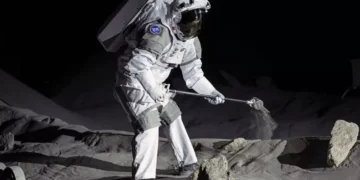The Moon is once again at the center of global space exploration efforts. As space agencies like NASA, the European Space Agency (ESA), and China’s National Space Administration (CNSA) gear up for crewed missions to our celestial neighbor, a new focus is emerging: using local lunar resources to build infrastructure. This concept, known as in-situ resource utilization (ISRU), relies heavily on the Moon’s regolith, commonly known as moon dust.
Advancements in Lunar Simulations
A key challenge in utilizing lunar resources is learning how to handle regolith effectively. Researchers at the University of Bristol have developed a groundbreaking virtual simulation that closely replicates the conditions on the Moon. This simulation enables precise sample collection, which can be mirrored by a robot in real-world settings. The experiment, conducted at ESA’s European Centre for Space Applications and Telecommunications (ESA-ESCAT), demonstrated the accuracy of this method.
Unlike previous methods that required live camera feeds, which are subject to delays due to the Moon’s distance, this simulation allows for commands to be sent to robots without needing continuous visual feedback. This innovation addresses one of the critical issues of teleoperation on the lunar surface—communication lags. By minimizing these lags, the simulation offers a promising path forward for remote-controlled lunar operations.
Importance of Efficient Regolith Handling
Lunar regolith isn’t just any kind of dust—it’s the key to sustaining human life on the Moon. Regolith as a Resource: Regolith can be converted into building materials using 3D printing technology, allowing for the creation of habitats and infrastructure. Beyond construction, the dust contains essential elements like oxygen and water, which can be extracted and used for life support or even to produce rocket fuel. This makes efficient handling of regolith crucial for the success of long-term lunar missions.
However, handling regolith presents several challenges. It is extremely abrasive and clings to surfaces due to electrostatic charging, which can complicate its collection and processing. Remote handling through teleoperated robots is essential, as it reduces the risks astronauts would face in directly interacting with the dust. The University of Bristol’s virtual simulation makes this process smoother, allowing for more accurate control of robotic movements and minimizing the impact of communication delays.
Benefits of the Simulation for Mission Planning
The new simulation model brings multiple benefits for future Moon missions, especially in terms of mission planning and execution. Preparing Astronauts: One of the simulation’s potential uses is in training astronauts for the conditions they’ll face on the Moon. It allows astronauts to practice handling moon dust with adjusted gravity and haptic feedback, giving them a sense of what to expect when working with lunar materials. This hands-on preparation can make all the difference when conducting complex tasks in an environment as challenging as the Moon’s surface.
Moreover, the virtual model could significantly reduce costs associated with developing new lunar technologies. Traditional methods often involve creating physical simulants that mimic regolith, which can be expensive and time-consuming. With the University of Bristol’s model, initial tests can be conducted digitally, enabling space agencies and private companies to fine-tune their technologies before deploying them in physical settings. This approach not only saves money but also accelerates the pace of innovation in lunar exploration.
Potential Challenges and Next Steps
Despite the promising potential of this simulation, some challenges remain. Addressing Communication Delays: One of the major hurdles in lunar teleoperation is the time delay in communications between Earth and the Moon, ranging from 5 to 14 seconds during deep-space missions. This delay is a notable increase from the 3-second lag experienced during the Apollo missions. Such a lag can impact real-time decision-making and operations. While the virtual simulation can help bridge this gap, further advancements are needed to ensure that remote operations are seamless.
The research team is also looking into the human aspect of interacting with these systems. Understanding how astronauts and mission controllers adapt to the delay and how they interact with the remote system will be crucial for refining the model further. This knowledge will help design better user interfaces and control systems, ensuring that future lunar missions are both efficient and safe.
Looking ahead, the team aims to refine the simulation to include more advanced scenarios, such as handling varied terrains and adapting to different regolith compositions. By expanding the scope of the simulation, they hope to provide a versatile tool that can be used across a variety of missions, from NASA’s Artemis program to China’s Chang’e missions. Such advancements could play a pivotal role in the success of lunar exploration in the next decade.
Conclusion
The development of a precise lunar simulation by the University of Bristol marks a significant step forward in preparing for sustained human presence on the Moon. By making it easier to handle regolith remotely and train astronauts for lunar conditions, this technology addresses some of the biggest challenges facing future Moon missions. With multiple crewed missions planned for the coming years, including those under NASA’s Artemis program, efficient use of lunar resources will be key to building a sustainable presence on the Moon.



















